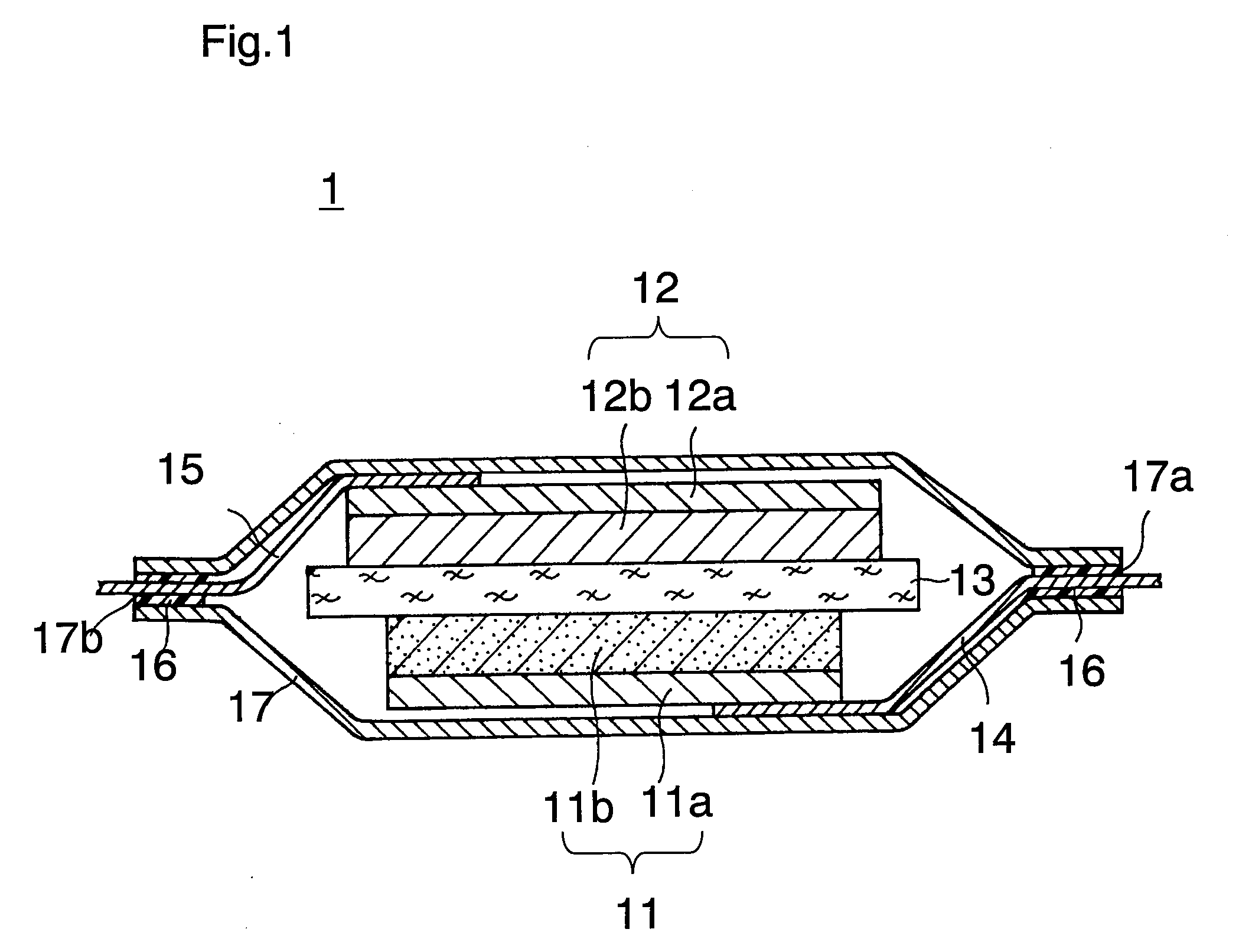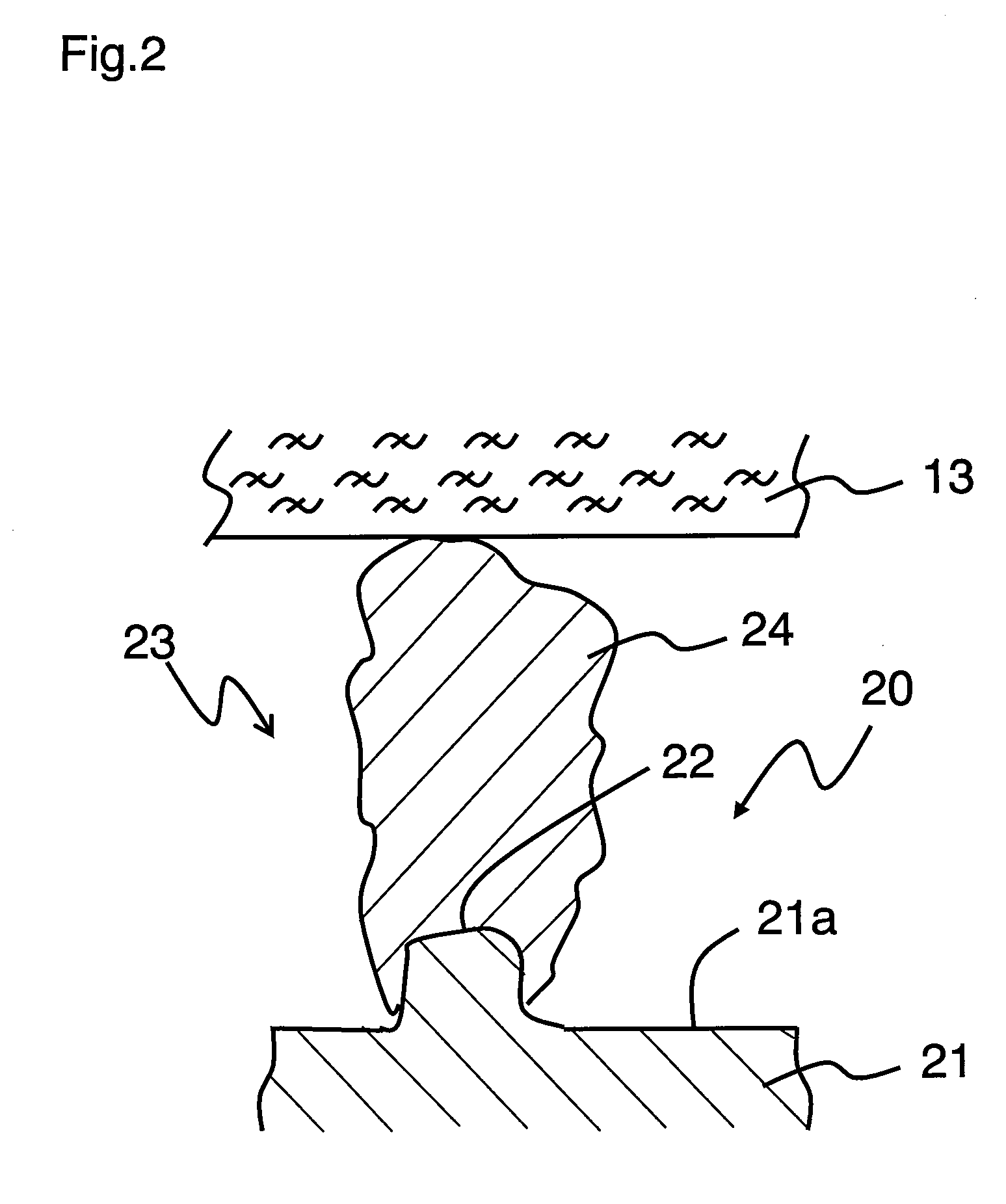Lithium ion secondary battery
a secondary battery and lithium ion technology, applied in the field of lithium ion secondary batteries, can solve the problems of battery safety reduction, and achieve the effects of high energy density, high output, and high safety
- Summary
- Abstract
- Description
- Claims
- Application Information
AI Technical Summary
Benefits of technology
Problems solved by technology
Method used
Image
Examples
example 1
(1) Positive Electrode Active Material Preparation
[0128]Sulfate of cobalt was added to an aqueous solution of NiSO4 such that Ni:Co=8.5:1.5 (molar ratio) was satisfied, thereby preparing an aqueous solution having a metal ion concentration of 2 mol / L. To this aqueous solution, a 2 mol / L sodium hydroxide solution was dripped gradually while stirring to neutralize, thereby producing by coprecipitation a ternary precipitate having a composition represented by Ni0.85CO0.15(OH)2. This precipitate was separated by filtration, washed with water, and dried at 80° C., thereby obtaining a composite hydroxide.
[0129]This composite hydroxide was heated in air at 900° C. for 10 hours, thereby obtaining a composite oxide having a composition represented by Ni0.85Cu0.15O. At this time, lithium hydroxide monohydrate was added so as to equalize the total number of Ni and Co atoms, and the number of Li atoms, and heated in air at 800° C. for 10 hours, thereby obtaining a lithium-nickel-containing comp...
example 2
[0147]A lithium ion secondary battery of the present invention was made in the same manner as Example 1, except that the production method of the positive electrode was changed as follows, and the oxygen removing layer was not formed.
[Positive Electrode Preparation]
[0148]A positive electrode material mixture paste was prepared by sufficiently mixing 93 g of a positive electrode active material (LiNi0.85CO0.15O2) powder prepared in the same manner as Example 1, 3 g of acetylene black (conductive agent), 4 g of polyvinylidene fluoride powder (binder), 5 g of SiO0.5 powder (oxygen deficient non-stoichiometric oxide, volume average particle size 3 μm), and 50 ml of N-methyl-2-pyrrolidone (NMP). This positive electrode material mixture paste was applied to both sides of aluminum foil (positive electrode current collector) with a thickness of 15 μm, dried, and rolled to form a positive electrode active material layer with a thickness of 135 μm.
example 3
[0149]A lithium ion secondary battery of the present invention was made in the same manner as Example 1, except that the production method of the negative electrode was changed as follows.
[Negative Electrode Preparation]
[0150]A ceramic layer with a thickness of 100 μm was formed by thermal spraying a chromic oxide on the surface of an iron-made roller with a diameter of 50 mm. A projection-forming roller was made by forming holes, i.e., circular recesses, with a diameter of 12 μm and a depth of 8 μm, on the surface of this ceramic layer by laser processing. Closest packing arrangement of these holes were carried out, with a distance between the axes of adjacent holes of 20 μm. The bottom of these holes was substantially planar at its center, and a portion connecting the periphery of the bottom with the side face is formed so as to be rounded off.
[0151]Alloy copper foil (product name: HCL-02Z, thickness 20 μm, manufactured by Hitachi Cable) containing 0.03 wt % zirconia relative to t...
PUM
| Property | Measurement | Unit |
|---|---|---|
| thickness | aaaaa | aaaaa |
| thickness | aaaaa | aaaaa |
| thickness | aaaaa | aaaaa |
Abstract
Description
Claims
Application Information
 Login to View More
Login to View More - R&D
- Intellectual Property
- Life Sciences
- Materials
- Tech Scout
- Unparalleled Data Quality
- Higher Quality Content
- 60% Fewer Hallucinations
Browse by: Latest US Patents, China's latest patents, Technical Efficacy Thesaurus, Application Domain, Technology Topic, Popular Technical Reports.
© 2025 PatSnap. All rights reserved.Legal|Privacy policy|Modern Slavery Act Transparency Statement|Sitemap|About US| Contact US: help@patsnap.com



